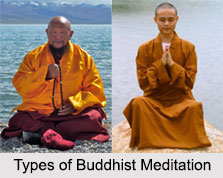 Types of Meditation are numerous which assert to keep the mind calm and composed. The breath tends to become slow, deep and regular. The mind revolves about the continuous rhythm of inhalation and exhalation which provides a natural object of meditation. Meditation can be initiated with the simple process of breath watching. Yoga and meditation is associated with a direct correlation between one"s breath and one"s state of the mind.
Types of Meditation are numerous which assert to keep the mind calm and composed. The breath tends to become slow, deep and regular. The mind revolves about the continuous rhythm of inhalation and exhalation which provides a natural object of meditation. Meditation can be initiated with the simple process of breath watching. Yoga and meditation is associated with a direct correlation between one"s breath and one"s state of the mind.
Meditation is a method which is considered to be an ancient approach for achieving a peaceful mind and attaining concentrated mind. It is practised to achieve a mind-body connection and to realize specific developmental goals. This very method is considered to be about 4,000 years old and is present since the beginning of Yoga. There are many different types of meditation that are practiced at present. Thus, the benefits from number of different types of meditation are also felt. All meditation types are found to be effective in reducing stress. These methods eliminate stress by creating detachment. Meditation compliments the physical world as the final step in spirituality, and honours the problems of life as the stimuli of growth.
There are various types of meditation and they can be categorized into broader approaches.
Concentrative Meditation: Concentrative meditation is the form that mainly focuses the attention on the breath, on an image, or a sound (mantra), which can be a soothing music. Concentrative meditation is practised by sitting quietly and focusing the attention on the breath. It concentrates on opening up the mind, to sense the five given sagacity and allows the mind to achieve greater awareness and clarity.
Mindfulness Meditation: Mindfulness meditation involves in opening the attention to become aware of the continuously passing parade of sensations, feelings, images, thoughts, sounds, smells, touch and so on, without becoming involved with each of them. It is the process of watching the mind and simply witnessing whatever goes through the mind. Thus a non-reactive state of mind can be achieved.
 Transcendental Meditation: Transcendental meditation is a diverse type of meditation which is related to repetition of a specific sound or a mantra. This mantra or sound has to be repeated or practiced according to specific procedure. The mind is engrossed in settling down or is “transcended†and a state of restful alertness is experienced.
Transcendental Meditation: Transcendental meditation is a diverse type of meditation which is related to repetition of a specific sound or a mantra. This mantra or sound has to be repeated or practiced according to specific procedure. The mind is engrossed in settling down or is “transcended†and a state of restful alertness is experienced.
Zen Meditation: Zen meditation involves Zazen, which is the centre of Zen meditation. It is a study of self and is believed to be a form of attaining enlightenment. It evokes a thought- free wakefulness so that the mind can reach its own Buddha nature.
Buddhist Meditation: Buddhist Meditation is divided into Samatha and Vipassana meditation. Samatha calms the mind and develops one-pointed concentration and positive emotions. Vipassana builds on this calmness and positivity and develops an awareness of the inner self.
Raja Yoga Meditation: This is the kind of meditation which is considered to be the king of all yogas. It gives the power to control one"s own mind. The mental connection between the soul and the Supreme soul or the remembrance of the supreme psyche by the soul is Raja yoga meditation. Through Raja yoga the soul achieves its peaceful and natural state very easily.
Mantra Meditation: Mantra meditation is a formula with spiritual significance that can help one relax very deeply. It involves thinking of a mantra and concentrating on it that helps one to focus one"s attention on the inside and eventually reach a state of very deep rest.
Chakra Meditation: Chakra meditation is also among the varied types of meditation. This engages "Chakra Anusadhna" which means "discovery or search of chakras". It is a simple way of meditation for beginners and helps awakening them gently, in a balanced and integrated way. Thus all the meditation kinds differ from one another.
Although, prayer and postures of each of the meditation technique are dissimilar, yet, a few meditation types have analogous course of action. Zen and Vipassana meditations are such that require the human body to be held in an immobile position and the attention of the mind is controlled. While in other meditation types like the Siddha yoga, the body and mind is left free, they are set open without any kind of control over them. However, all these meditation practices have one thing in common; they all attempt to bring the wandering and busy mind to a peaceful and calm state. Each of these meditation types makes a person aware of his/ her five sense organs and also help in developing a sixth sense, to some extent. Meditation helps to relax the muscles and brain and endow with the positive energy.



